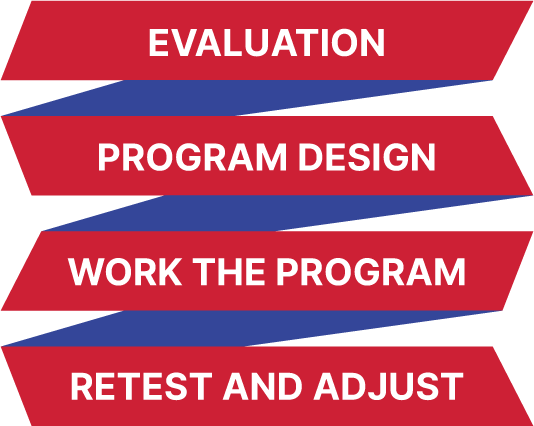THE RAPID PROCESS
Our sophisticated and specific process sets us apart from most.
Athletes start with a movement assessment and performance test to help understand their strengths, weaknesses, and potential for injury.
This provides us with the baseline data on athletic qualities like speed, force, and power, ultimately providing us with a roadmap to design a training program that will maximize results.
We then design a program with staged, achievable goals, and the hard part begins. You work the program.
Retesting occurs on a periodic basis, providing insight for adjustment and refinement to your training program.

Our training is far from a cookie-cutter, one-size-fits-all, approach.
Evaluation
understanding the baselines
The RAPID Process begins with meeting with your performance coach to learn about your injury history, training background, and your “why” for coming in.
The intent is to gather the needed information in order to design an intelligent plan to achieve your goals.
- 1 on 1 table assessment & consultation
- Baseline performance testing
- A deep-dive into your athletic history and potential
- 45-60 minute workout to analyze movement patterns and overall fitness level
- NOTE: Different assessment guidelines for athletes under 14 years old
The Table Assessment identifies range of motion limitations & postural concerns.
Areas that lack range of motion result in compensations, which often lead to a decrease in performance and a higher risk for injury.
Posture also influences movement patterns, so understanding how to correct this will drive better results.
Our Jump mat test is used to measure an athlete’s vertical jump/leg power.
Acceleration is key in most sports. The 10-yard dash is a standard measurement as a key indicator of an athlete’s ability to generate force in order to get to top speed.
The Keiser Air Squat measures lower body power with the athlete doing an explosive squat using their bodyweight as the resistance.
The Proteus System tests 3D resistance and power, something that has never been done before.
The report provides the athlete with accurate measurements in power, imbalances, explosiveness, and range of motion.
As an advanced test, this is done at the trainer’s discretion based on the client’s age and fitness level.
RAPID has acquired two Proteus machines for generating advanced metrics.
Goal Setting
It’s important to have a vision on where you want to go and what specific result you are striving for. Your performance coach will work with you to put together attainable bodyweight, speed, and power goals so that we track your progress and ensure you’re moving in the right direction.
- Power
- Speed
- Bodyweight
- Timeline
- Injury prevention
- Injury recovery
Program Design
defining goals and methodologies
- Analysis of your athlete profile and development of your individualized program
- Excel spreadsheet outlining your program in detail
- Program is stored at RAPID location
- Custom digital program
- NOTE: Different program guidelines for athletes under 14 yrs old
Work the Program
it’s time to get to work!
Now that you have all the tools, it’s time to get to work!
Remember, this is a process. Maintaining discipline by coming in consistently and having specific intent with your workouts will ultimately be the key to your success.
-
Ages 10-12: 60 minute training sessions
Ages 13+: 90 minute sessions - Consistency is key
Retest and Adjust
Approximately every 4 weeks, your coach will retest previous performance measurements in order to track the progress you have made and see what adjustments might be needed.
Your program will progress for the next month’s block, as you will experience new exercises or variations, along with intensity and resistance modifications depending on your situation.
- Approximately every four weeks

